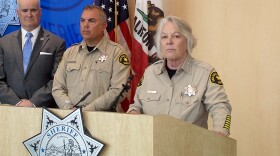In a parking garage at UC San Diego there’s a row of electric charging ports where students and staff plug in to be sure they have the power to drive home after classes are done.
“It’s interesting to see how many people drive electric cars here,” said pre-med student Isaiah Cabebe, who just got done charging his hybrid car.
“Especially with a lot of kids I know who live in condos where they’re not able to charge at home, having these here are really, really helpful.”
UC San Diego has more than 500 electric car chargers, making it one of the world’s biggest public charging networks. Professor David Victor said he still expects UCSD’s charging infrastructure to grow by the factor of three.
“If the state’s policy goals are met, by 2035 all new cars will be effectively electric vehicles. Then we’re going to see a lot more electric vehicles on the road and much bigger need for the infrastructure to charge those vehicles, not just at home but also in workplaces and on the roads,” said Victor, a professor of innovation and public policy who co-directs UCSD’s energy decarbonization initiative.
If California is going to achieve its ambitious goals for reducing carbon emissions, a key factor is changing what we drive and how we get around.
The EPA said transportation is the nation’s biggest contributor to carbon emissions. Within transportation light duty vehicles, cars and pickup trucks emit 57% of the greenhouse gases.
Cars don’t have to be electric to be zero emission. But a lot of people think battery-powered electric vehicles just make the most sense because electric resources are so widely available.
“We already have an electric grid, we already have the infrastructure,” said Jae Kim, professor and chair of the industrial and systems engineering department at the University of San Diego. “If you were to do, for example, hydrogen vehicles, you’d have to start from scratch, basically, and try to build up that whole infrastructure.”
So what will a fleet of mostly electric cars do to California’s power grid?
The California Energy Commission forecasts that in 2035 EVs will represent 20% of the total energy demand that California utilities must provide for.
In San Diego, power demand and grid congestion are lowest overnight, and that’s why it’s cheapest to charge your car overnight. The problem is most overnight power comes from carbon-emitting natural gas plants because renewable sources don’t produce power when the wind doesn’t blow and the sun doesn’t shine.
Victor said that’s why workplace charging is the best option because daylight hours are the time when carbon-free solar power in California is abundant.
“What we’re doing here at UC San Diego is asking the question. Suppose in addition to congestion we’re also concerned about the emissions that are caused by our vehicles. And if you add those emissions, it already makes sense to charge in the middle of the day than at night. The (costs) just don’t reflect that yet,” Victor said.
“If the state’s policy goals are met, by 2035 all new cars will be effectively electric vehicles. Then we’re going to see a lot more electric vehicles on the road and much bigger need for the infrastructure to charge those vehicles, not just at home but also in workplaces and on the roads.”David Victor, UC San Diego professor of innovation and public policy
Electric vehicle owners who own their own homes are most likely to have a home charger. But students at UCSD are looking for other places to fill their cars with electrons.
Apartment dweller Stella Riley, who got a Volkswagen ID.4 about a month ago, almost always charges on campus while she attends classes.
She said as a new EV driver, her charging habits remain a work in progress.
“It depends on my mood! If I feel like charging it, I will. Normally I wait until it gets a little bit lower because if it’s at 60% I won’t charge it but once it gets to 40, I’m like hmmm … I should charge my car!” Riley said.
As charging infrastructure expands, there are some possible trends in car ownership that could make EVs less of a power burden than we may think.
Kim said a lot of people predict the future will bring less individual car ownership, and more people who rent time from public fleets of autonomous, self-driving cars. That kind of system would make it easier to coordinate resources.
“You could spread out the charging much easier and you could match the supply and demand for mobility much easier,” Kim said. “As a result, you could also then match the supply and demand of electricity easier as well.”
For now, Victor said cost and convenience will be major factors as to when people charge their cars. But he hopes they will drive Californians to fill up their electric cars in the middle of the day.






